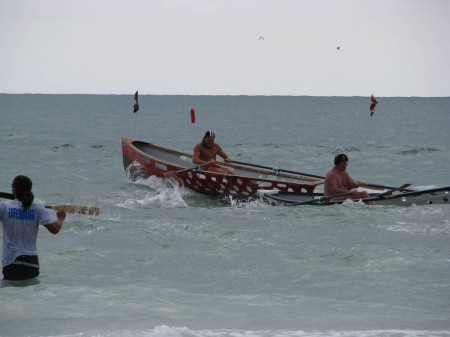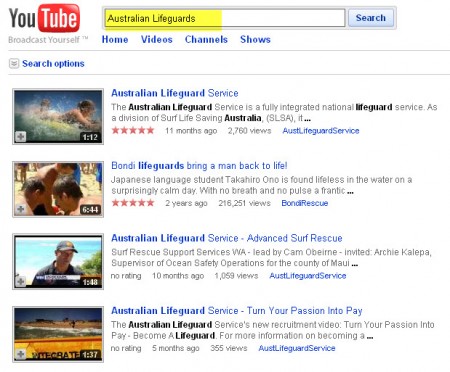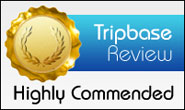
A well-equipped lifeguard station can make the difference between life and death for swimmers in trouble.
Posted by David McRee at BlogTheBeach.com
I don’t usually make comments about shark bite incidents. Most shark bite reports in the newspapers and on news channels tend to lack enough detail to really explain what happened. This latest case of a kite surfer being fatally bitten south of Stuart Beach in Florida is different, and instructive. It also compels me to ask some serious questions.
On Wednesday February 3, 2010, 38 year-old Stephen Schafer was kite-boarding some distance off of Stuart beach on Florida’s southeast coast when he was bitten by a shark. Exactly how the bite occurred is not known or is not being reported yet. I would assume he fell at some point and was bitten before he could get back up on his board. Not important to this discussion.
There are a couple of important points about this incident that I think we should all think about:
- According to reports, Schafer was kite surfing alone, approximately a quarter mile offshore.
- Schafer was kite surfing in an area not officially guarded by the lifeguards at Stuart beach.
- According to Daniel Lund, one of the apparently two lifeguards who rescued Schafer, it took about 20 minutes to reach Schafer using a long surfboard and another 20 minutes to get back to the beach.
- The lifeguards did not realize that sharks were involved until they were very close to Schafer who informed them he had been bitten.
Several unfortunate factors coincided to turn this incident into a fatal one for Schafer. There was only one lucky break for Schafer but it wasn’t enough.
The first bad luck was influenced by Schafer himself: he was surfing alone a long way from shore and had no one close by to help him. Would he have survived if he had a buddy? No one knows for sure, but it certainly would have increased his chances. Any of us who has ever been on any kind of surfboard has probably surfed alone at some point. It happens. I’ve done it. Not a quarter mile offshore, to be sure, but alone nevertheless.
The lucky break was that a very alert lifeguard, Daniel Lund, realized that Schafer appeared to be having difficulties in the water, even though Schafer was not in Lund’s guarded area. Now for the really bad break: Lund had no way of knowing the truly serious trouble that Schafer was in. Lund and a fellow lifeguard paddled a quarter mile out into the Atlantic Ocean using long surfboards, taking, according to Lund speaking on the O’reilly Factor Friday evening, probably 20 minutes to reach Schafer, and another 20 minutes to get back to the beach. Assuming that Schafer had probably been in trouble for at least 5 minutes before Lund and company determined he was in trouble, Schafer was probably bleeding for the better part of 45 minutes and was in shock by the time they got back to the beach. That’s way too long.
[Note: I am making the reasonable assumption that the lifeguards used the best equipment, methods and information about Schafer’s condition available to them at that moment to get to Schafer as quickly as possible. The fact that it took 40 minutes to get Schafer back to the beach is in no way a relection on the skills, training, efforts, or dedication of the lifeguards .]
There are a lot of things I just don’t know about this situation. How well equipped are the Martin County lifeguards? A quarter mile is a long way for a lifeguard to have to paddle to help someone. Lund’s arms must have been like lead weights by the time he reached Schafer. Did they not have a surf boat? A jet-ski? Either one of those would have shaved perhaps 20 to 30 minutes or more off the rescue time. I’m not trying to lay blame, I’m just asking perhaps the same questions that Lund himself might be asking; the questions that every Florida beach town should be asking.
If you don’t know about this incident, here’s a video that explains some of the details. There is a better video on the local West Palm Beach T.V. station’s YouTube channel but they’ve disabled embedding so I can’t put it in this blog. Apparently they don’t understand the real value of YouTube, but that’s another story. If you’ve already heard the story, the video below does not contain any new info:
A few years ago I attended a lifeguarding competition on Siesta Key Beach. Lifeguards from all over the southeastern U.S. were there showing off their skills and equipment. I was amazed at how fast they could launch their surf boats through the waves, row out beyond a buoy and row back to the beach. Amazing. Does Martin County not have that capability? Should they have? Should every beach community? Is a human paddling a surfboard the best equipment for the job? I’m not an expert on ocean rescue…I’m just asking the first question that popped into my mind.

Surf boats can be launched quickly into the ocean and are a valuable tool for lifeguarding. These boats are being launched at the Southeast Regional Lifeguarding Competition in 2008.
Some people say we don’t have any real heroes anymore. Baloney. Lifeguards are heroes. The Martin County lifeguards found themselves in water full of sharks and blood but they did what they had to do. They are heroes. And they’ll go back out and do it again tomorrow if they need to.
There are a lot of what-if’s in this story but here are the two most significant:
- What if Schafer hadn’t been kite-surfing alone?
- What if the lifeguards had been able to get to Schafer more quickly, stop the bleeding, and get him back to shore right away?
For years I”ve been hearing that Florida does not take beach safety seriously enough. Since our main attraction is the beach that’s kind of surprising isn’t it? Take Lee County on the southwest Gulf coast, for instance: no lifeguards. Not a single one. And the Florida panhandle has long been criticized for not having enough lifeguards.
I decided to look around on YouTube for information on lifeguarding and here’s what I found:
Brevard County: Rescuers Plead for More Lifeguards
And yet another. I’m not picking on Brevard, but it is representative of a statewide issue:
How about this YouTube search result for “Volusia County Lifeguards” This is not the way our lifeguards should be portrayed on the internet:

This is how the Volusia County Lifeguards are represented on YouTube. Can't we do better than this? Sure we can. I happen to know that Volusia County has a very good Beach Patrol / Lifeguard service.
Quite a contrast with the YouTube results below for “Australian Lifeguards”:

The Australians seem to have the edge on us. They are proud of their Lifeguards and they promote them heavily.
Here’s an Austrailian Lifeguard video. Do you see some pretty nice surf rescue equipment in this Australian video?:
Or this one from the United Kingdom. Wait, is that a BOAT they are using? Why yes, I believe it is!
Do we invest enough in our lifeguards?
Do they all have the equipment they need? No doubt some do, but what about the rest?
Each of us has a responsibility toward our own personal safety (I know I won’t be surfing alone anymore). But at some level it is beneficial to society as a whole, and to our tourism industry, to make our beach visitors and watersports enthusiasts feel like all reasonable efforts are made to ensure their safety.
It is possible that no amount of rescue equipment would have saved Stephen Schafer, but we still have to ask the tough questions. Schafer was a valuable member of the community and was loved by many. He deserved every chance.
Let’s make sure our brave lifeguards have the equipment and training they need to do their jobs. And let’s make all populated beaches lifeguarded beaches.
If you’re concerned about your family being safe at the beach, download my free ebook on beach safety:


